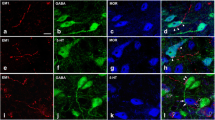Abstract
ALTHOUGH anatomical and neurochemical studies suggest that endogenous opioids act as neurotransmitters1–7, their roles in normal and pathophysiological regulation of synaptic transmission are not defined. Here we examine the actions of prodynorphin-derived opioid peptides in the guinea-pig hippocampus and show that physiological stimulation of the dynorphin-containing dentate granule cells can release endogenous dynorphins, which then activate κ1 opioid receptors present in the molecular layer of the dentate gyrus. Activation of κ1 receptors by either pharmacologically applied agonist or endogenously released peptide reduces excitatory transmission in the dentate gyrus, as shown by a reduction in the excitatory postsynaptic currents evoked by stimulation of the perforant path, a principal excitatory afferent. In addition, released dynorphin peptides were found to block the induction of long-term potentiation (LTP) at the granule cell-perforant path synapse. The results indicate that endogenous dynorphins function in this hippocampal circuit as retrograde, inhibitory neurotransmitters.
Similar content being viewed by others
References
Gall, C., Brecha, N., Karten, H. J. & Chang, K. J. comp. Neurol. 198, 335–350 (1981).
McGinty, J. F., Henriksen, S. J., Goldstein, A., Terenius, L. & Bloom, F. E. Proc. natn. Acad. Sci. U.S.A. 80, 589–593 (1983).
Chavkin, C., Shoemaker, W. J., McGinty, J. F., Bayon, A. & Bloom, F. E. J. Neurosci. 5, 808–816 (1985).
McLean, S., Rothman, R., Jacobson, A., Rice, K. & Herkenham, M. J. comp. Neurol. 255, 497–510 (1987).
Chavkin, C., Bakhit, C., Weber, E. & Bloom, F. E. Proc. natn. Acad Sci. U.S.A. 80, 7669–7673 (1983).
Wagner, J. J., Evans, C. & Chavkin, C. J. Neurochem. 57, 333–343 (1991).
Wagner, J. J., Caudle, R. M. & Chavkin, C. J. Neurosci. 12, 132–141 (1992).
Lahti, R., Mickelson, M., McCall, J. & von Voightlander, P. Eur. J. Pharmac. 109, 281 (1985).
Zukin, R., Eghbali, M., Olive, D., Unterwald, E. & Tempel, A. Proc. natn. Acad. Sci. U.S.A. 85, 4061–4065 (1988).
Portoghese, P. S., Lipkowski, A. W. & Takemori, A. E. Life Sci. 40, 1287–1292 (1987).
Nock, B., Giordano, L., Cicero, T. & O'Connor, L. J. Pharmac. exp. Ther. 254, 412–419 (1990).
Jan, L. Y. & Jan, Y. N. J. Physiol., London 327, 219–246 (1982).
Lundberg, J. M., Rudehill, A., Sollevi, A., Theodorsson-Norheim, E. & Hamberger, B. Neurosci. Lett. 63, 96–100 (1986).
Bliss, T. V. P. & Lomo, T. J. Physiol. 232, 331 (1973).
Lynch, G. & Baudry, M. Science 224, 1057–1063 (1984).
Madison, D. V., Malenka, R. C. & Nicoll, R. A. Rev. Neurosci. 14, 379–397 (1991).
Martinez, J. L., Janak, P. H., Weinberger, S. G., Schulties, G. & Derrick, R. E. in NIDA Res. Monogr. 97 (ed. Erinoff, L.) 48–78 (US Govt Printing Office, Washington DC, 1990).
Decker, M. W. & McGaugh, J. L. Synapse 7, 151–168 (1991).
Jiang, H. K., Owyang, V., Hang, J. S. & Gallagher, M. Proc. natn. Acad. Sci. U.S.A. 86, 2948–2951 (1989).
Gallagher, M., Bostock, E. & King, R. A. Behavl Neural Biol. 44, 374–385 (1985).
Collier, T. J. & Routtenberg, A. Brain Res. 310, 384–387 (1984).
Bramham, C., Milgram, N. & Srebo, B. Brain Res. 567, 42–50 (1991).
Xie, C. W. & Lewis, D. V. J. Pharmac. exp. Ther. 256, 289–296 (1991).
Tortella, F. C. Trends pharmac. Sci. 9, 366–372 (1988).
Singh, L., Vass, C. A., Hunter, J. C., Woodruff, G. N. & Hughes, J. Eur. J. Pharmac. 191, 477–480 (1990).
Jones, L. S. Brain Res. 564, 336–340 (1991).
Houser, C. R., Miyashiro, J. E., Walsh, G. O., Rich, J. R. & Delgado-Escueta, A. V. J. Neurosci. 10, 267–282 (1990).
Sloviter, R. S. Neurosci. Lett. 137, 91–96 (1992).
Cronin, J., Obenaus, A., Houser, C. R. & Dudek, F. E. Brain Res. 573, 305–310 (1992).
Evans, C., Erdelyi, E., Hunter, J. & Barchas, J. J. Neurosci. 5, 3423–3427 (1985).
Weisskopf, M. G., Zalutsky, R. A. & Nicoll, R. A. Nature 362, 423–427 (1993).
Author information
Authors and Affiliations
Rights and permissions
About this article
Cite this article
Wagner, J., Terman, G. & Chavkin, C. Endogenous dynorphins inhibit excitatory neurotransmission and block LTP induction in the hippocampus. Nature 363, 451–454 (1993). https://doi.org/10.1038/363451a0
Received:
Accepted:
Issue Date:
DOI: https://doi.org/10.1038/363451a0
- Springer Nature Limited
This article is cited by
-
Dichotomous regulation of striatal plasticity by dynorphin
Molecular Psychiatry (2023)
-
Dynorphin Counteracts Orexin in the Paraventricular Nucleus of the Thalamus: Cellular and Behavioral Evidence
Neuropsychopharmacology (2018)
-
Endogenous opioids regulate moment-to-moment neuronal communication and excitability
Nature Communications (2017)
-
Plasma membrane poration by opioid neuropeptides: a possible mechanism of pathological signal transduction
Cell Death & Disease (2015)
-
Biomarkers of Epileptogenesis: Psychiatric Comorbidities (?)
Neurotherapeutics (2014)




